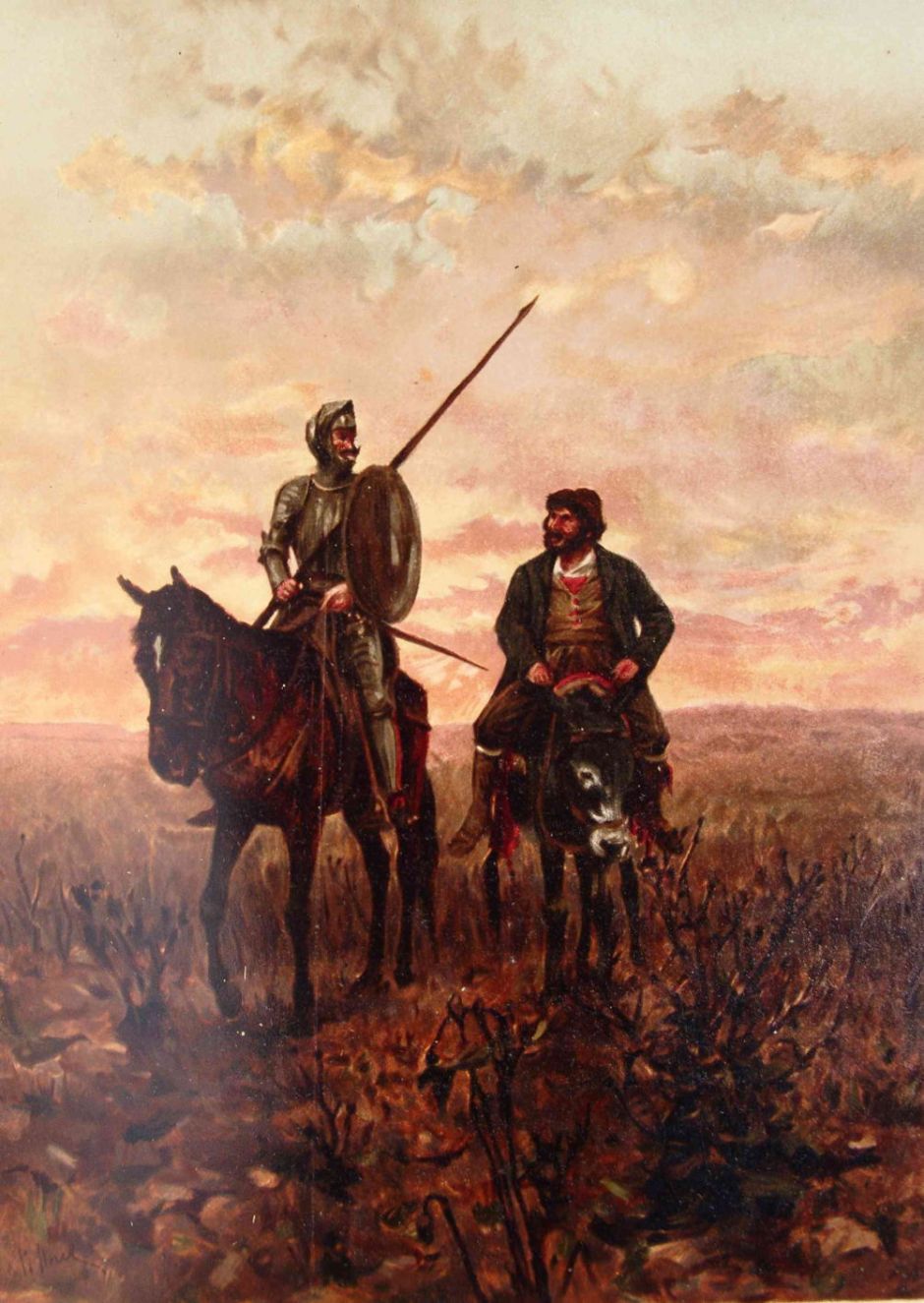In the previous episode, Don Quixote and Sancho Panza were staying at an inn, when Don Pedro the puppeteer with a performing ape turned up. They went to a performance of his puppet theatre, and when the Moors went after a Christian couple, Don Quixote ran amok, smashing the puppets to pieces with his sword. Don Pedro was heartbroken, but the knight paid him compensation for the damage. The following morning they went their separate ways, the knight and his squire heading off to see the River Ebro. It’s revealed that Don Pedro was one of the convicts in the chain-gang that Don Quixote had freed, and had also stolen Sancho’s donkey earlier. A couple of days later, the pair came across the villagers who brayed, now organised into an army two hundred strong. When Sancho offended them by braying, he was knocked to the ground and Don Quixote was forced to flee, with Sancho laid on his donkey.
When Sancho’s donkey reached Don Quixote, the squire slid off its saddle. The knight checked him over, but couldn’t find any external sign of injury, so told him off for upsetting the villagers by braying at them. Sancho responded by accusing his master of abandoning him.

They rode over to some trees, Sancho still groaning from the pain in his spine, and complaining bitterly about his lot as a squire. When he pointed out that he’d been paid two ducats a month in the past, Don Quixote agreed that he should be paid two reals a month, and told the squire to work out how much he was owed.
Then Don Quixote found a way to make Sancho feel remorse for thinking about money, and persuaded him to drop the idea completely. They rode into the grove, where they dismounted and settled down to sleep, Sancho still aching all over, and Don Quixote with his memories.

They reached the bank of the River Ebro a couple of days later, where Don Quixote saw a boat moored to a tree on the bank. He told Sancho to dismount, as he felt drawn to that boat, as if it had been left there on purpose, to enable their next adventure. As Sancho tied their mounts to a tree, he told his master that the boat was most likely used for fishing. Undeterred, Don Quixote jumped on board, and when Sancho had joined him in the craft he cut its mooring rope to start it drifting slowly away from the bank.
Sancho began to tremble with fear, but his master chided him for his cowardice, and pontificated about Ptolemy and the equinoctial line (equator) which he said they should soon cross. They steadily drifted towards some large watermills, which Don Quixote claimed were a city or fortress in which there was a knight or queen in distress, waiting to be rescued by him.

Neither of the occupants of the boat had noticed how it was gathering speed as it approached the watermills. The millers could see that the craft was drifting into danger, and rushed off to fetch long poles with which to fend it off. Their hands and faces were still covered in the flour the mill was grinding, and they shouted at the pair in the boat to take action, but Don Quixote misread their actions, stood up, hurled abuse back at them and drew his sword.


By now, the boat was entrained in the mill race and Sancho was on his knees praying as hard as he could. The millers thrust their poles at the boat, but couldn’t avoid capsizing it and throwing its occupants into the river. Although Don Quixote could swim like a fish, the weight of his armour dragged him down to the bottom twice before the millers could drag him out. While that was happening, the empty boat was being smashed to small fragments by the massive mill wheels.

Next the fishermen who owned the boat turned up, demanding payment from the knight, who calmly informed them that he’d gladly pay, so long as they’d hand over the person who was imprisoned in their castle. When they accused him of lunacy, the knight apologised to whoever it was inside for being unable to rescue them. Don Quixote told Sancho to settle with the fishermen, who could only stand in amazement alongside the millers, as Don Quixote and Sancho Panza made their way back to their animals.
That completes the twenty-ninth chapter of the second book of Don Quixote.
Further reading
Wikipedia
List of characters
English translation by John Ormsby (1885)
Miguel de Cervantes Saavedra, trans John Rutherford (1604, 2000) Don Quixote, Penguin, ISBN 978 0 140 44909 9.
Roberto González Echevarría (2015) Cervantes’ Don Quixote, Yale UP, ISBN 978 0 300 19864 5.
Roberto González Echevarría (ed) (2005) Cervantes’ Don Quixote, A Casebook, Oxford UP, ISBN 978 0 19 516938 6.

